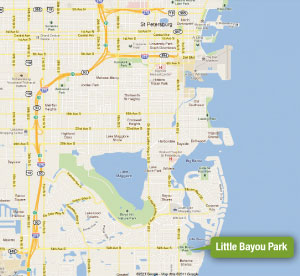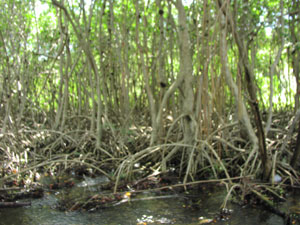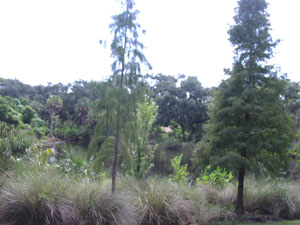 |
||||||||

Little Bayou Park:
The Amazing Renaissance of a Small Park Leads to Big Things
By Ray Wunderlich III and Ron Chicone
Little Bayou Park holds a unique place in history as well as a special space in the region's ecology.
From a historical perspective, its shores once saw a Union sloop bombard the home of southern sympathizer and early pioneer, Abel Miranda, who lived on Big Bayou just to the north. It was also called home by one of St. Petersburg's first pioneers and its first postmaster general, John Bethel, in the mid 1800s. Bethel describes the land as a poor choice to raise "truck crops" (pumpkins, squash, beans, watermelons, etc.) referring to an 1868 settler's attempt to farm a section then known as "The Maple Swamp" with disastrous results. Later, citrus performed poorly on it as well. Some of the foundation's remains can still be found in Little Bayou, and one of the oldest homes in St. Petersburg, circa 1915, abuts the property.
Sometime in the early 1900s, a large portion of the bayfront property was purchased by banking magnate Hubert Rutland Sr., and became a wild, forested playground for his family. The Rutland's 30-acre site was sold to the City of St. Petersburg in the early 1970s. Then, during Mayor Baker's administration, the northern third of the parcel was sold and developed as a condominium community.
The remaining 19-acre section is now known as Little Bayou Park. The woodsy site is one of only a few remaining section of the natural coastline that originally lined most of Tampa Bay and it is officially designated as a "Wild Park" by the city.
I had known this mysterious, untouched, and largely forgotten forest existed from my days running through it on the cross-country team at nearby Lakewood High School. In 2004, working as a volunteer naturalist with the Florida Native Plant Society, I re-discovered Little Bayou Park. With the knowledge I gained through FNPS on the relationships among ecosystems and a penchant for making this park an ecologically productive learning tool, I formulated a proposal for restoring Little Bayou. The City embraced the proposal and we set about its renaissance.
The park encompasses four separate ecosystems: a distinctive mangrove swamp, a maritime hardwood hammock, pine flatwoods and a freshwater marsh system. Its watershed, however, is mostly residential but still includes Lake Vista, several seepage springs, and a channelized creek that flows through the park before reaching the bay.
Its position at the mouth of Little Bayou Creek gives it an environmental significance beyond its relatively small size. It is a sentinel against urban pollution protecting the bay from plastic bottles, cans, plastic wrappers, old shoes, pesticides, fertilizers, engine oil, human and animal waste, heavy metals and anything that washes down the storm drains. This stream is designated as an "impaired water body" by the state due to low dissolved oxygen, high fecal coliform counts, excessive nutrient levels and high mercury levels.
Along with contaminants deposited by water, the site was considered a "free dump" for years. We found trash that ranged from construction debris and furniture to plastics, old bicycles and even a dumped swing set. Dumping probably included yard waste containing exotic plants that had become ubiquitous and impenetrable in the park. To date, 26 non-native invasive plant species have been identified in Little Bayou Park. The most abundant include shoebutton Ardesia (Ardesia elliptica), Senegal date palm (Phoenix reclinata), lead tree (Leucaena leucocephala), air potato (Dioscorea bulbifera), swamp eucalyptus (Eucalyptus robusta), pothos (Epipremnum pinnatum) and Brazilian pepper (Schinus terebinthifolius).
Through the efforts and collaborations of the concerned volunteers and the multiple grants (including two from the Tampa Bay Estuary Program), over 3500 plantings of native trees and shrubs are flourishing in the park. Along with the trash, over 1500 cubic yards of vegetative debris were removed from the woods and wetlands. Over the last seven years, 14 organizations, 900 people donating 3300 volunteer hours, 16 official workdays (including two "Give-A-Day For The Bay" workdays), and the University of South Florida's Environmental Science and Policy Laboratory classes have contributed mightily to the improved ecology of the area.
The years-long dedication of volunteers from across the region has made Little Bayou a showcase for what a small group of committed people can accomplish:
• Never has an all-volunteer force working in conjunction with the city restored such a large area and continued to help maintain it.
• No other cumulative mass of volunteer hours has equaled this commitment to restoring a St. Petersburg park.
• Never have so many entities including government, non-profit, neighborhood, private, and community, collaborated for one effort.
• Never has a volunteer effort been able to scientifically identify and document the plant and animal species occurring in an undermanaged St. Petersburg park. Many botanical specimens, including some previously undocumented invasives, of the park's flora have been preserved and are on file at the USF Herbarium.
• Little Bayou also is the first interactive outdoor laboratory, integrating classroom experiences for students at USF who are learning aspects of habitat restoration, botany, ecology, non-native invasive plant removal, taxonomy, and public-private collaborations.
Recognizing those accomplishments, Little Bayou Park received the Tampa Bay Estuary Program's Golden Mangrove Award for the best project in the Tampa Bay Area for 2010. The City of St. Petersburg awarded the author and his two USF interns "Sunshine Ambassador" awards for their outstanding efforts in making St. Petersburg a better place.
The success of this effect has increased the wetland and upland animal species quantity and quality, and numerous species have been documented including bald eagle, great blue herons, white ibis, four different woodpeckers, green heron, limpkin, little blue heron, yellow-crested night heron, kingfisher, gopher tortoise, chicken turtle, black snake, a yellow rat snake, osprey, reddish egret, snook, crow, grackle, warblers, many songbirds and over 15 species of butterflies.
Neighbors have shown an increased pride and respect for the site by picking up trash and keeping an observant eye on the area. No homeless people frequent the area anymore and usage of the park has increased. The city plans to list Little Bayou Park in its Parks and Recreation pamphlet for the first time.
Although we recognize Little Bayou is a small physical space at just 19 acres, it is the last natural area of its kind bordering Tampa Bay from Weddon Island to Maximo Park and serves critical environmental functions. Its pond, creek and wetlands are a last line of defense in protecting the bay from polluted runoff, and they help manage flooding during storms. The restoration of the park's rich natural habitats has created an ecological laboratory that is educating students and residents about the importance of a healthy environment.
It exemplifies the reality that actions have consequences, both positive and negative, in our local and global spheres. This continuing renaissance in Little Bayou Park shows how collaborative efforts and caring citizens must forge the way to an improved environment, a healthier community, and a better world.
Ray Wunderlich III a project leader in park restorative efforts. Ron Chicone is a professional ecologist. Both are active in the Florida Native Plant Society.



 Zoom
Zoom
